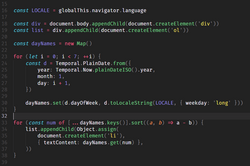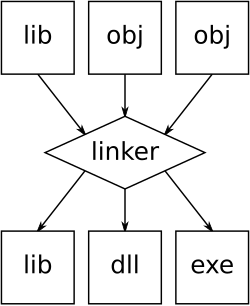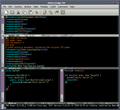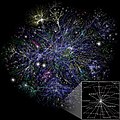Portal:Computer programming
Portal topics - (Random portal)
The Computer Programming Portal
Computer programming or coding is the composition of sequences of instructions, called programs, that computers can follow to perform tasks. It involves designing and implementing algorithms, step-by-step specifications of procedures, by writing code in one or more programming languages. Programmers typically use high-level programming languages that are more easily intelligible to humans than machine code, which is directly executed by the central processing unit. Proficient programming usually requires expertise in several different subjects, including knowledge of the application domain, details of programming languages and generic code libraries, specialized algorithms, and formal logic.
Auxiliary tasks accompanying and related to programming include analyzing requirements, testing, debugging (investigating and fixing problems), implementation of build systems, and management of derived artifacts, such as programs' machine code. While these are sometimes considered programming, often the term software development is used for this larger overall process – with the terms programming, implementation, and coding reserved for the writing and editing of code per se. Sometimes software development is known as software engineering, especially when it employs formal methods or follows an engineering design process. (Full article...)
Selected articles - load new batch
- Image 1The history of artificial intelligence (AI) began in antiquity, with myths, stories, and rumors of artificial beings endowed with intelligence or consciousness by master craftsmen. The study of logic and formal reasoning from antiquity to the present led directly to the invention of the programmable digital computer in the 1940s, a machine based on abstract mathematical reasoning. This device and the ideas behind it inspired scientists to begin discussing the possibility of building an electronic brain.
The field of AI research was founded at a workshop held on the campus of Dartmouth College in 1956. Attendees of the workshop became the leaders of AI research for decades. Many of them predicted that machines as intelligent as humans would exist within a generation. The U.S. government provided millions of dollars with the hope of making this vision come true.
Eventually, it became obvious that researchers had grossly underestimated the difficulty of this feat. In 1974, criticism from James Lighthill and pressure from the U.S.A. Congress led the U.S. and British Governments to stop funding undirected research into artificial intelligence. Seven years later, a visionary initiative by the Japanese Government and the success of expert systems reinvigorated investment in AI, and by the late 1980s, the industry had grown into a billion-dollar enterprise. However, investors' enthusiasm waned in the 1990s, and the field was criticized in the press and avoided by industry (a period known as an "AI winter"). Nevertheless, research and funding continued to grow under other names. (Full article...) - Image 2

Scala (/ˈskɑːlɑː/ SKAH-lah) is a strong statically typed high-level general-purpose programming language that supports both object-oriented programming and functional programming. Designed to be concise, many of Scala's design decisions are intended to address criticisms of Java.
Scala source code can be compiled to Java bytecode and run on a Java virtual machine (JVM). Scala can also be transpiled to JavaScript to run in a browser, or compiled directly to a native executable. When running on the JVM, Scala provides language interoperability with Java so that libraries written in either language may be referenced directly in Scala or Java code. Like Java, Scala is object-oriented, and uses a syntax termed curly-brace which is similar to the language C. Since Scala 3, there is also an option to use the off-side rule (indenting) to structure blocks, and its use is advised. Martin Odersky has said that this turned out to be the most productive change introduced in Scala 3.
Unlike Java, Scala has many features of functional programming languages (like Scheme, Standard ML, and Haskell), including currying, immutability, lazy evaluation, and pattern matching. It also has an advanced type system supporting algebraic data types, covariance and contravariance, higher-order types (but not higher-rank types), anonymous types, operator overloading, optional parameters, named parameters, raw strings, and an experimental exception-only version of algebraic effects that can be seen as a more powerful version of Java's checked exceptions. (Full article...) - Image 3Forth is a stack-oriented programming language and interactive integrated development environment designed by Charles H. "Chuck" Moore and first used by other programmers in 1970. Although not an acronym, the language's name in its early years was often spelled in all capital letters as FORTH. The FORTH-79 and FORTH-83 implementations, which were not written by Moore, became de facto standards, and an official technical standard of the language was published in 1994 as ANS Forth. A wide range of Forth derivatives existed before and after ANS Forth. The free and open-source software Gforth implementation is actively maintained, as are several commercially supported systems.
Forth typically combines a compiler with an integrated command shell, where the user interacts via subroutines called words. Words can be defined, tested, redefined, and debugged without recompiling or restarting the whole program. All syntactic elements, including variables, operators, and control flow, are defined as words. A stack is used to pass parameters between words, leading to a Reverse Polish notation style.
For much of Forth's existence, the standard technique was to compile to threaded code, which can be interpreted faster than bytecode. One of the early benefits of Forth was size: an entire development environment—including compiler, editor, and user programs—could fit in memory on an 8-bit or similarly limited system. No longer constrained by space, there are modern implementations that generate optimized machine code like other language compilers. The relative simplicity of creating a basic Forth system has led to many personal and proprietary variants, such as the custom Forth used to implement the bestselling 1986 video game Starflight from Electronic Arts. (Full article...) - Image 4

Portion of the calculating machine with a printing mechanism of the analytical engine, built by Charles Babbage, as displayed at the Science Museum (London)
The analytical engine was a proposed digital mechanical general-purpose computer designed by English mathematician and computer pioneer Charles Babbage. It was first described in 1837 as the successor to Babbage's difference engine, which was a design for a simpler mechanical calculator.
The analytical engine incorporated an arithmetic logic unit, control flow in the form of conditional branching and loops, and integrated memory, making it the first design for a general-purpose computer that could be described in modern terms as Turing-complete. In other words, the structure of the analytical engine was essentially the same as that which has dominated computer design in the electronic era. The analytical engine is one of the most successful achievements of Charles Babbage.
Babbage was never able to complete construction of any of his machines due to conflicts with his chief engineer and inadequate funding. It was not until 1941 that Konrad Zuse built the first general-purpose computer, Z3, more than a century after Babbage had proposed the pioneering analytical engine in 1837. (Full article...) - Image 5In computing, a compiler is a computer program that translates computer code written in one programming language (the source language) into another language (the target language). The name "compiler" is primarily used for programs that translate source code from a high-level programming language to a low-level programming language (e.g. assembly language, object code, or machine code) to create an executable program.
There are many different types of compilers which produce output in different useful forms. A cross-compiler produces code for a different CPU or operating system than the one on which the cross-compiler itself runs. A bootstrap compiler is often a temporary compiler, used for compiling a more permanent or better optimised compiler for a language.
Related software include decompilers, programs that translate from low-level languages to higher level ones; programs that translate between high-level languages, usually called source-to-source compilers or transpilers; language rewriters, usually programs that translate the form of expressions without a change of language; and compiler-compilers, compilers that produce compilers (or parts of them), often in a generic and reusable way so as to be able to produce many differing compilers. (Full article...) - Image 6Laboratory Virtual Instrument Engineering Workbench (LabVIEW) is a graphical system design and development platform produced and distributed by National Instruments, based on a programming environment that uses a visual programming language. It is widely used for data acquisition, instrument control, and industrial automation. It provides tools for designing and deploying complex test and measurement systems.
The visual (aka graphical) programming language is called "G" (not to be confused with G-code). It is a dataflow language originally developed by National Instruments. LabVIEW is supported on a variety of operating systems (OSs), including macOS and other versions of Unix and Linux, as well as Microsoft Windows.
The latest versions of LabVIEW are LabVIEW 2024 Q3 (released in July 2024) and LabVIEW NXG 5.1 (released in January 2021). National Instruments released the free for non-commercial use LabVIEW and LabVIEW NXG Community editions on April 28, 2020. (Full article...) - Image 7Mya was an intelligent personal assistant under development by Motorola. Proposed features for the program included the ability to read emails and answer questions 24 hours a day. Mya was intended to work with an internet service Motorola was developing called Myosphere, and was planned to be a paid service that would eventually be used by other mobile carriers. A female computer-generated character was created to represent Mya in advertising. While the quality of the character's animation was praised, it received criticism for being over sexualised.
Both the character and the program were announced to the public via an advertisement in March 2000, though the program was not ready for use at that time. Despite the announcement generating a considerable amount of attention, little was heard regarding the project in subsequent months. The program was never officially released nor cancelled, though the trademarks for both Myosphere and Mya were abandoned by Motorola in 2002. The name Mya was believed to be a play on the words 'My assistant'. (Full article...) - Image 8
Andrew Stuart Tanenbaum (born March 16, 1944), sometimes referred to by the handle AST, is an American-born Dutch computer scientist and retired professor emeritus of computer science at the Vrije Universiteit Amsterdam in the Netherlands.
He is the author of MINIX, a free Unix-like operating system for teaching purposes, and has written multiple computer science textbooks regarded as standard texts in the field. He regards his teaching job as his most important work. Since 2004 he has operated Electoral-vote.com, a website dedicated to analysis of polling data in federal elections in the United States. (Full article...) - Image 9

Flowchart of using successive subtractions to find the greatest common divisor of number r and s
In mathematics and computer science, an algorithm (/ˈælɡərɪðəm/ ⓘ) is a finite sequence of mathematically rigorous instructions, typically used to solve a class of specific problems or to perform a computation. Algorithms are used as specifications for performing calculations and data processing. More advanced algorithms can use conditionals to divert the code execution through various routes (referred to as automated decision-making) and deduce valid inferences (referred to as automated reasoning).
In contrast, a heuristic is an approach to solving problems without well-defined correct or optimal results. For example, although social media recommender systems are commonly called "algorithms", they actually rely on heuristics as there is no truly "correct" recommendation.
As an effective method, an algorithm can be expressed within a finite amount of space and time and in a well-defined formal language for calculating a function. Starting from an initial state and initial input (perhaps empty), the instructions describe a computation that, when executed, proceeds through a finite number of well-defined successive states, eventually producing "output" and terminating at a final ending state. The transition from one state to the next is not necessarily deterministic; some algorithms, known as randomized algorithms, incorporate random input. (Full article...) - Image 10

Source code for a computer program written in the JavaScript language. It demonstrates the appendChild method. The method adds a new child node to an existing parent node. It is commonly used to dynamically modify the structure of an HTML document.
A computer program is a sequence or set of instructions in a programming language for a computer to execute. It is one component of software, which also includes documentation and other intangible components.
A computer program in its human-readable form is called source code. Source code needs another computer program to execute because computers can only execute their native machine instructions. Therefore, source code may be translated to machine instructions using a compiler written for the language. (Assembly language programs are translated using an assembler.) The resulting file is called an executable. Alternatively, source code may execute within an interpreter written for the language.
If the executable is requested for execution, then the operating system loads it into memory and starts a process. The central processing unit will soon switch to this process so it can fetch, decode, and then execute each machine instruction. (Full article...) - Image 11

tcsh and sh shell windows on a Mac OS X Leopard desktop
A Unix shell is a command-line interpreter or shell that provides a command line user interface for Unix-like operating systems. The shell is both an interactive command language and a scripting language, and is used by the operating system to control the execution of the system using shell scripts.
Users typically interact with a Unix shell using a terminal emulator; however, direct operation via serial hardware connections or Secure Shell are common for server systems. All Unix shells provide filename wildcarding, piping, here documents, command substitution, variables and control structures for condition-testing and iteration. (Full article...) - Image 12

An illustration of the linking process. Object files and static libraries are assembled into a new library or executable
A linker or link editor is a computer program that combines intermediate software build files such as object and library files into a single executable file such as a program or library. A linker is often part of a toolchain that includes a compiler and/or assembler that generates intermediate files that the linker processes. The linker may be integrated with other toolchain tools such that the user does not interact with the linker directly.
A simpler version that writes its output directly to memory is called the loader, though loading is typically considered a separate process. (Full article...) - Image 13Object Pascal is an extension to the programming language Pascal that provides object-oriented programming (OOP) features such as classes and methods.
The language was originally developed by Apple Computer as Clascal for the Lisa Workshop development system. As Lisa gave way to Macintosh, Apple collaborated with Niklaus Wirth, the author of Pascal, to develop an officially standardized version of Clascal. This was renamed Object Pascal. Through the mid-1980s, Object Pascal was the main programming language for early versions of the MacApp application framework. The language lost its place as the main development language on the Mac in 1991 with the release of the C++-based MacApp 3.0. Official support ended in 1996.
Symantec also developed a compiler for Object Pascal for their Think Pascal product, which could compile programs much faster than Apple's own Macintosh Programmer's Workshop (MPW). Symantec then developed the Think Class Library (TCL), based on MacApp concepts, which could be called from both Object Pascal and THINK C. The Think suite largely displaced MPW as the main development platform on the Mac in the late 1980s. (Full article...) - Image 14

The Greek lowercase omega (ω) character is used to represent Null in database theory.
In SQL, null or NULL is a special marker used to indicate that a data value does not exist in the database. Introduced by the creator of the relational database model, E. F. Codd, SQL null serves to fulfill the requirement that all true relational database management systems (RDBMS) support a representation of "missing information and inapplicable information". Codd also introduced the use of the lowercase Greek omega (ω) symbol to represent null in database theory. In SQL,NULLis a reserved word used to identify this marker.
A null should not be confused with a value of 0. A null indicates a lack of a value, which is not the same as a zero value. For example, consider the question "How many books does Adam own?" The answer may be "zero" (we know that he owns none) or "null" (we do not know how many he owns). In a database table, the column reporting this answer would start with no value (marked by null), and it would not be updated with the value zero until it is ascertained that Adam owns no books.
In SQL, null is a marker, not a value. This usage is quite different from most programming languages, where a null value of a reference means it is not pointing to any object. (Full article...) - Image 15
Eiffel is an object-oriented programming language designed by Bertrand Meyer (an object-orientation proponent and author of Object-Oriented Software Construction) and Eiffel Software. Meyer conceived the language in 1985 with the goal of increasing the reliability of commercial software development. The first version was released in 1986. In 2005, the International Organization for Standardization (ISO) released a technical standard for Eiffel.
The design of the language is closely connected with the Eiffel programming method. Both are based on a set of principles, including design by contract, command–query separation, the uniform-access principle, the single-choice principle, the open–closed principle, and option–operand separation.
Many concepts initially introduced by Eiffel were later added into Java, C#, and other languages. New language design ideas, particularly through the Ecma/ISO standardization process, continue to be incorporated into the Eiffel language. (Full article...)
Selected images
- Image 1A head crash on a modern hard disk drive
- Image 3Partial view of the Mandelbrot set. Step 1 of a zoom sequence: Gap between the "head" and the "body" also called the "seahorse valley".
- Image 4A lone house. An image made using Blender 3D.
- Image 5GNOME Shell, GNOME Clocks, Evince, gThumb and GNOME Files at version 3.30, in a dark theme
- Image 6An IBM Port-A-Punch punched card
- Image 7Output from a (linearised) shallow water equation model of water in a bathtub. The water experiences 5 splashes which generate surface gravity waves that propagate away from the splash locations and reflect off of the bathtub walls.
- Image 8Ada Lovelace was an English mathematician and writer, chiefly known for her work on Charles Babbage's proposed mechanical general-purpose computer, the Analytical Engine. She was the first to recognize that the machine had applications beyond pure calculation, and to have published the first algorithm intended to be carried out by such a machine. As a result, she is often regarded as the first computer programmer.
- Image 9This image (when viewed in full size, 1000 pixels wide) contains 1 million pixels, each of a different color.
- Image 10Deep Blue was a chess-playing expert system run on a unique purpose-built IBM supercomputer. It was the first computer to win a game, and the first to win a match, against a reigning world champion under regular time controls. Photo taken at the Computer History Museum.
- Image 11Stephen Wolfram is a British-American computer scientist, physicist, and businessman. He is known for his work in computer science, mathematics, and in theoretical physics.
- Image 15Margaret Hamilton standing next to the navigation software that she and her MIT team produced for the Apollo Project.
- Image 16A view of the GNU nano Text editor version 6.0
- Image 17Grace Hopper at the UNIVAC keyboard, c. 1960. Grace Brewster Murray: American mathematician and rear admiral in the U.S. Navy who was a pioneer in developing computer technology, helping to devise UNIVAC I. the first commercial electronic computer, and naval applications for COBOL (common-business-oriented language).
- Image 18Partial map of the Internet based on the January 15, 2005 data found on opte.org. Each line is drawn between two nodes, representing two IP addresses. The length of the lines are indicative of the delay between those two nodes. This graph represents less than 30% of the Class C networks reachable by the data collection program in early 2005.
Did you know? - load more entries

- ... that it took a particle accelerator and machine-learning algorithms to extract the charred text of PHerc. Paris. 4 without unrolling it?
- ... that Rust has been named the "most loved programming language" every year for seven years since 2016 by annual surveys conducted by Stack Overflow?
- ... that the Gale–Shapley algorithm was used to assign medical students to residencies long before its publication by Gale and Shapley?
- ... that the software-testing framework pytest has been described as a key ecosystem project for the Python programming language?
- ... that the programming language Acorn System BASIC was so non-standard that one commenter suggested that using it on the BBC Micro would be a disaster?
- ... that the study of selection algorithms has been traced to an 1883 work of Lewis Carroll on how to award second place in single-elimination tournaments?
Subcategories
WikiProjects
- There are many users interested in computer programming, join them.
Computer programming news
No recent news
Topics
Related portals
Associated Wikimedia
The following Wikimedia Foundation sister projects provide more on this subject:
 Commons
Commons
Free media repository Wikibooks
Wikibooks
Free textbooks and manuals Wikidata
Wikidata
Free knowledge base Wikinews
Wikinews
Free-content news Wikiquote
Wikiquote
Collection of quotations Wikisource
Wikisource
Free-content library Wikiversity
Wikiversity
Free learning tools Wiktionary
Wiktionary
Dictionary and thesaurus


















































